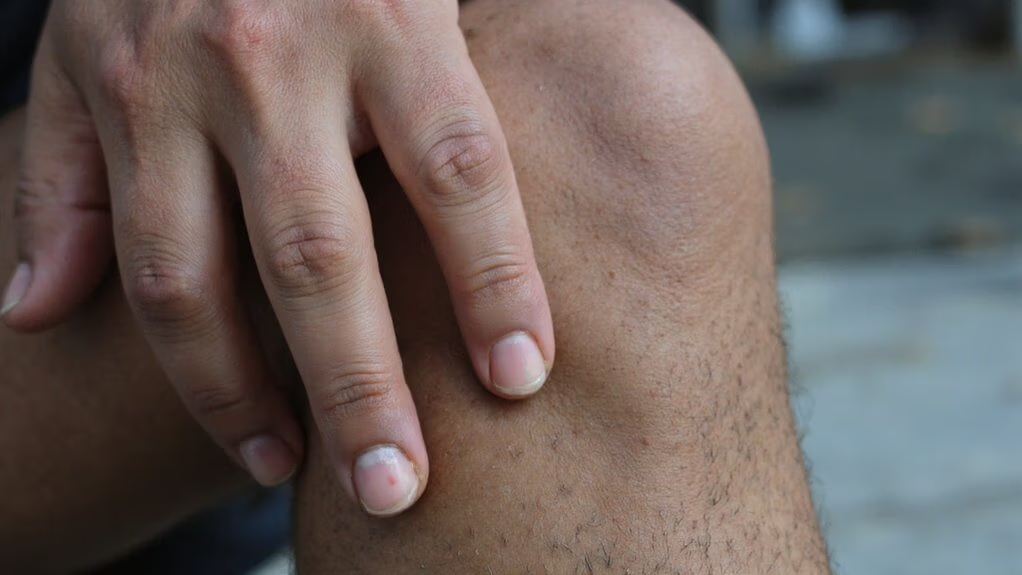If you’re noticing tingling around your mouth, numbness in your fingers or frequent muscle cramps, you may have low calcium. You’ll also get twitching, positive Chvostek or Trousseau signs, and in severe cases spasms or seizures. These symptoms often link to vitamin D or magnesium issues too—keep going to see how it’s diagnosed and treated.
Why Calcium Matters for Your Body

Although you might think of calcium mainly as a bone nutrient, it plays essential roles throughout the body: it’s the primary mineral for bone mineralization and structural strength, and it directly enables skeletal and cardiac muscle contraction, nerve impulse transmission, blood clotting, and intracellular signaling pathways that regulate hormone secretion and cell function. You rely on tight serum calcium regulation; parathyroid hormone and vitamin D coordinate absorption, resorption, and renal handling to keep ionized calcium within narrow ranges. When intake, absorption, or hormonal control falters, cellular processes and organ systems become vulnerable. Clinically, maintaining adequate calcium supports skeletal resilience, cardiovascular stability, neurologic function, and hemostasis; you’ll want targeted assessment and evidence-based interventions if risk factors are present. Discuss options with clinicians who prioritize innovation.
Early Warning Signs to Watch For

When calcium starts to fall below the range your body needs, the earliest signs are usually neuromuscular: perioral numbness, paresthesias of the hands and feet, frequent muscle cramps and intermittent spasms, and positive Chvostek or Trousseau signs on exam.
- Increasing dental sensitivity or enamel deterioration
- Dry, brittle nails or persistent xerosis
- Unexplained fatigue, reduced concentration, or cognitive “fog”
- Cardiac sensations (palpitations) or episodes of lightheadedness
Beyond neuromuscular clues, you should monitor these systemic indicators and act promptly. Review diet and medications, order targeted labs (total/ionized calcium, albumin, PTH, vitamin D), and collaborate with your clinician to implement evidence-based, innovative monitoring and treatment. Follow-up plans should include periodic reassessment of labs and bone health metrics to track response and adjust therapy.
Muscle and Neurological Symptoms

You may notice frequent muscle cramps or involuntary spasms, especially in your calves, hands, or around the mouth, which are common manifestations of low calcium. You might also experience persistent numbness or a tingling “pins and needles” sensation in the hands, feet, or face, reflecting altered nerve excitability. If you have these symptoms, report them to your clinician so they can assess serum calcium, review medications and vitamin D status, and guide appropriate treatment.
Muscle Cramps and Spasms
Because low ionized calcium raises neuromuscular excitability, you’re more likely to get painful muscle cramps, tetany, and focal spasms such as carpopedal tightening or nocturnal calf cramps. You should recognize patterns and triggers, and seek timely assessment when spasms are recurrent or severe. Management targets correcting serum ionized calcium and addressing reversible contributors. Practical measures include hydration, calibrated oral calcium and vitamin D, and targeted physical therapy. Monitor response and ECG if severe. Innovations in ambulatory monitoring and point-of-care ionized calcium assays can improve diagnosis and care. Discuss options with your clinician for individualized plans.
- Typical features: sudden, involuntary, painful contraction
- Timing: often nocturnal or activity-related
- Severity guide: interrupts sleep or daily function
- When to seek urgent care: prolonged tetany or respiratory involvement immediately
Numbness and Tingling
How does low calcium produce numbness and tingling? Low extracellular calcium increases neuronal membrane excitability, lowering the threshold for action potentials, so you experience paresthesia—pins-and-needles or numbness—especially around the mouth, hands and feet. Hypocalcemia can impair peripheral nerve conduction and alter neuromuscular junction transmission, producing sustained tingling or transient loss of sensation. In clinical settings you may also notice concurrent muscle cramps, Chvostek or Trousseau signs, or cognitive changes; these findings support biochemical testing. Diagnosis relies on serum ionized calcium, corrected total calcium, and assessment of magnesium and vitamin D. Treatment restores calcium and addresses underlying causes—vitamin D deficiency, hypoparathyroidism, or renal disease—so you rapidly reduce symptoms and prevent neurological sequelae. Follow-up monitoring with targeted innovation in delivery improves outcomes and tracks patient-centered metrics.
Bone Health and Fracture Risk
When dietary calcium is inadequate, your bones lose mineral density and become more fracture-prone. You’ll notice increased risk for low-impact fractures as cortical and trabecular bone weaken; clinicians use DXA to quantify this loss and guide therapy. Addressing deficiency reduces fracture incidence when paired with targeted exercise and pharmacologic options. Monitor serum calcium, vitamin D, and bone turnover markers to personalize care. Consider innovations like AI-assisted fracture prediction and telemedicine follow-up to optimize outcomes.
- Reduced bone mineral density on DXA
- Heightened low-energy fracture risk
- Slower microarchitectural repair
- Need for individualized treatment plans
Early intervention with calcium optimization, vitamin D repletion, lifestyle modification, and when indicated, antiresorptive or anabolic agents, reduces morbidity and preserves mobility and supports long-term independence and function.
Dental and Nail Changes
As serum calcium drops, you may notice specific changes in your teeth and nails that reflect impaired mineralization and altered keratinocyte function. You might experience enamel hypoplasia, increased dental caries, delayed eruption in children, and tooth sensitivity from weakened dentin. In nails, expect brittle, ridged, or spoon-shaped (koilonychia) changes when calcium-dependent processes falter. These signs correlate with prolonged hypocalcemia and often coexist with vitamin D deficiency or hypoparathyroidism; targeted biochemical testing (serum calcium, phosphate, PTH, 25‑OH vitamin D) clarifies etiology. Management combines correcting calcium balance, addressing contributing deficiencies, and dental or dermatologic interventions to restore function and aesthetics. Monitor response objectively with serial labs and focused clinical exams, and integrate innovative supplementation or topical strategies when standard therapies fall short to optimize patient outcomes.
Heart and Cardiovascular Effects
Low calcium can disrupt your heart’s electrical signalling, increasing the risk of arrhythmias and producing palpitations. Epidemiological and physiologic data link hypocalcemia to higher blood pressure risk via effects on vascular smooth muscle tone. Severe or prolonged deficiency may weaken cardiac contractility, so you should report new palpitations, dizziness, or exertional breathlessness to your clinician.
Arrhythmias and Palpitations
Because calcium shapes cardiac myocyte action potentials and excitation–contraction coupling, hypocalcemia often causes palpitations and rhythm disturbances; you’ll commonly see sinus tachycardia, premature ventricular complexes, QT-interval prolongation and, in severe cases, ventricular arrhythmias such as torsades de pointes. You should report new palpitations, syncope or lightheadedness promptly; clinicians will correlate symptoms with ECG changes and serum calcium. Immediate management targets reversible contributors and stabilizes rhythm while you undergo definitive correction. Monitoring includes telemetry and serial electrolytes, and advanced care may require IV calcium and antiarrhythmic strategies.
- Obtain 12-lead ECG and continuous telemetry
- Check ionized calcium, magnesium, potassium and albumin
- Initiate IV calcium gluconate for symptomatic hypocalcemia
- Consult cardiology for malignant or persistent arrhythmias
You and your team should prioritize rapid diagnosis and targeted correction.
Increased Blood Pressure Risk
Although acute hypocalcemia often reduces vascular tone, chronic calcium insufficiency and the ensuing secondary hyperparathyroidism increase systemic vascular resistance and raise long‑term blood pressure and cardiovascular risk. You should know calcium influences endothelial function, smooth muscle contractility, and renin–angiotensin signaling; deficiency disrupts these pathways, promoting vasoconstriction and arterial stiffness. Observational studies link low dietary calcium and low serum calcium to higher incidence of hypertension, and mechanistic work implicates elevated parathyroid hormone as a mediator. Clinically, you’ll monitor blood pressure trends when correcting calcium, consider targeted supplementation and lifestyle modifications, and evaluate secondary causes. Emerging therapeutics and precision-nutrition strategies aim to normalize calcium-regulatory hormones without oversupplementation. Discuss individualized risk, benefits, and monitoring with your clinician to reduce long-term cardiovascular harm. Monitor inflammatory vascular biomarkers regularly.
Cardiac Muscle Weakness
When serum calcium falls, your myocardium loses the ionic support it needs for reliable excitation–contraction coupling, and contractile strength drops while electrical stability worsens. You may notice exertional fatigue, reduced exercise tolerance, palpitations, or syncope; these reflect impaired myocyte calcium cycling and altered action potential duration. Evaluate with ECG, troponin, and serum electrolytes; consider calcium and vitamin D status and reversible causes. Management targets normalization of ionized calcium, addressing hypomagnesemia, and tailored cardiac monitoring.
- Reduced systolic performance and decreased ejection fraction risk
- Prolonged QT interval predisposing to arrhythmia
- Exertional intolerance from impaired contractility
- Need for targeted electrolyte correction and surveillance
You should discuss rapid correction plans and innovative monitoring options, including wearable ECG and point‑of‑care ionized calcium assays in clinical
Who Is Most at Risk of Low Calcium
Are you at higher risk for low calcium? You are if you have inadequate dietary intake, limited dairy or fortified foods, or follow strict vegan or elimination diets. Older adults—especially postmenopausal women—lose bone calcium due to hormonal changes and reduced absorption. Patients with chronic kidney disease, malabsorption syndromes (celiac, Crohn’s), or prior bariatric surgery have impaired calcium handling. Long-term use of proton-pump inhibitors, loop diuretics, or certain anticonvulsants also increases risk. Hypoparathyroidism and vitamin D deficiency compound risks by disrupting regulation and absorption. Infants fed unfortified formula or exclusively breastfed without maternal adequacy may be vulnerable. Assess risk by reviewing history, medications, comorbidities, and diet; prioritize targeted prevention and individualized supplementation when evidence supports it. Coordinate care with clinicians and dietitians for best outcomes.
How Calcium Is Measured and Diagnosed
To check for calcium deficiency, your clinician will usually start with a serum total calcium test, which measures both bound and free calcium in a blood sample and is often corrected for albumin. If results are borderline or you’re critically ill, they’ll order ionized calcium measurement, the physiologically active fraction that provides a more accurate assessment of your calcium status. Interpreting these tests alongside albumin, parathyroid hormone, and your symptoms helps guide diagnosis and treatment.
Serum Calcium Tests
How is calcium measured, and what will the results tell you about your health? Serum (total) calcium is measured from a routine blood draw; labs report values in mg/dL and you’ll get context via reference ranges. Clinicians correct total calcium for albumin to estimate biologically active calcium, review trends, and correlate results with symptoms, medications, and kidney function. Interpretation guides further testing and treatment decisions.
- Total serum calcium (lab assay) with reference range
- Albumin-adjusted correction to improve accuracy
- Comparison to prior results to detect trends
- Correlation with symptoms, meds, renal status, and endocrine causes
You’ll expect repeat testing or specialist referral when results are abnormal or inconsistent with clinical findings. Modern labs use standardized assays, but you should note inter-lab variability and instrument advances.
Ionized Calcium Measurement
Ionized calcium is the physiologically active fraction of serum calcium and gives a more accurate picture of calcium status when protein levels or blood pH are abnormal.
| Test | Purpose | Notes |
|---|---|---|
| Ionized Ca | Direct active calcium | Measured in whole blood |
| Corrected Ca | Adjusts for albumin | Uses formula; less accurate |
| Total Ca | Routine screening | Affected by proteins and pH |
You should request ionized calcium when you need definitive assessment: it’s measured in blood gas analyzers, avoids albumin correction errors, and informs acute management. Interpret results alongside pH and albumin, standardize sampling (anaerobic, minimal delay), and use ionized values to guide replacement and monitor therapy. Emerging point-of-care platforms speed decisions in innovative care settings. Clinicians and technologists should collaborate to validate workflows and uphold patient-centered quality standards.
Dietary Sources and Supplements
When dietary intake falls short, you’ll need to rely on targeted food choices and, if necessary, supplements to meet recommended calcium targets (generally 1,000–1,200 mg/day for most adults). Consider these high-yield food sources:
- Dairy and fortified plant milks
- Canned sardines and salmon with bones
- Calcium-set tofu and legumes
- Low-oxalate greens (kale, bok choy) rather than spinach
Note oxalate-rich greens have lower bioavailability and may not be sufficient alone. When supplements are indicated, prefer evidence-based formulations: calcium carbonate offers more elemental calcium; calcium citrate is better tolerated with achlorhydria. Aim for divided doses ≤500 mg to optimize absorption and limit interactions; check labels for vitamin D co-formulation. You should review dosing periodically with testing and adjust therapy based on results.
Lifestyle Steps to Improve Calcium Levels
Optimizing lifestyle factors can meaningfully support calcium balance and bone health, and you should prioritize targeted, evidence-based changes rather than broad or vague advice. You’ll optimize intake by choosing calcium-rich foods and pairing them with vitamin D–enhancing strategies: sensible sun exposure, fortified foods, or personalized supplementation guided by serum 25(OH)D. Weight-bearing and resistance exercise stimulate bone remodeling and increase calcium deposition; aim for progressive loading three times weekly. Limit factors that impair absorption: cut excess sodium, moderate caffeine and alcohol, and avoid smoking. Review medications with your clinician that can affect calcium handling. Consider periodic bone density testing and serum calcium monitoring if you have risk factors. Integrate these steps into a measurable plan and reassess outcomes with your healthcare team every six months.
Conclusion
If you notice numbness, tingling, cramps, persistent fatigue, bone or dental symptoms, get evaluated promptly. We’ll check ionized and corrected serum calcium, magnesium and vitamin D, review medications and diet, and assess fracture risk. Dietary adjustments, weight‑bearing exercise and targeted supplementation (guided by labs) usually restore levels and reduce complications. Seek urgent care for severe spasms, laryngospasm or seizures. We’ll tailor treatment to your needs, monitoring response.